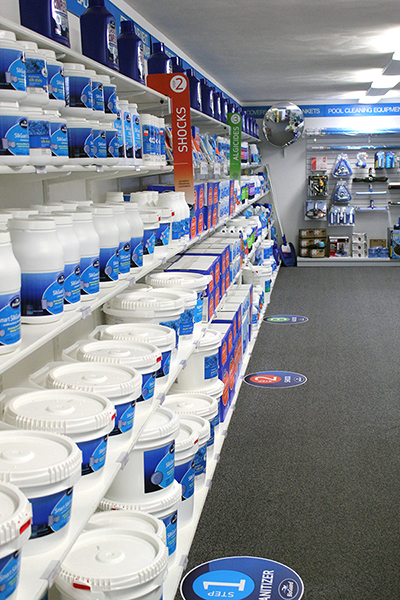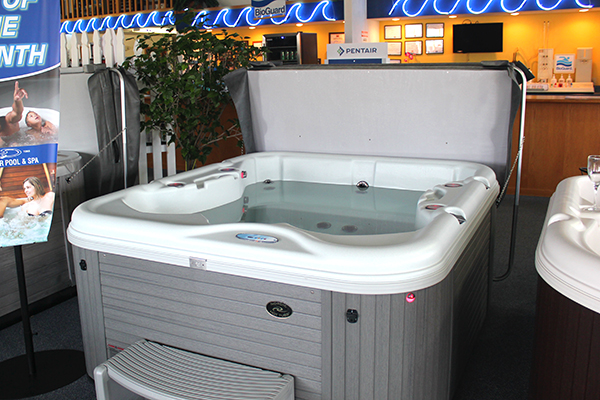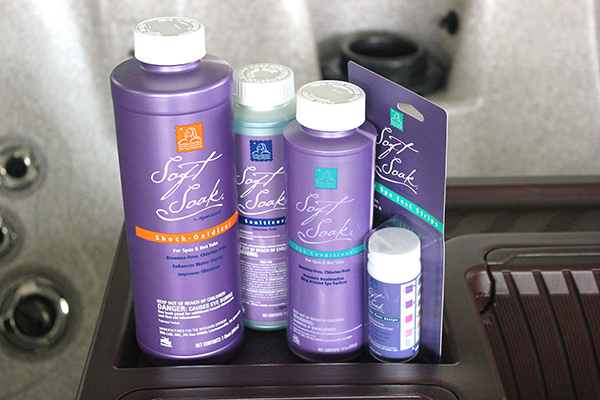Maintenance Tips
- When setting up your pool for the season in the spring, here are the simple first steps: start up your pool, get the filter system up and running, clean the pool and backwash. After 24 hours, bring a water sample into our showroom in a clean jar, sandwich bag, or water sample bottle. This must be done after 24 hours to ensure accurate test results, which is critical to how we will advise you on what’s needed to balance or maintain the pool water.
- If you have a solid winter cover on your pool, water will gather on top throughout the season. Don’t try to remove the cover without pumping all that water off first: every gallon of water weighs more than 8 pounds, so if you have just an inch of water on your winter cover – that’s more than a thousand pounds of weight. If you don’t remove the water with a pump, it will end up in the pool, decomposing leaves and other natural waste included. It disrupts the delicate balance in your pool and creates a chlorine demand – not a great way to start off a new season of pool fun!
- We all love our dogs – but it might be the best bet to keep Fido out of the pool! A single dog in the pool carries the same germs and bacteria of fifty people. If you choose to let your furry friend in the pool, plan on adding more chemicals and making sure skimmers and pump baskets are cleaned more often. Or… consider a dog pool. We sell a chew-resistant one that’s made out of the same material as truck bed liners. It’s a great alternative, with a built-in drain that makes it easy to fill and clean.
- Struggling with earthworms in your in-ground pool? This can be a common frustration, depending on the kind of spring we have. These critters naturally seek out moist areas and crawl out of the soil during rain storms. Once the rain stops, they dry out and look for the nearest source of water, which often happens to be your pool. Since they cannot swim like other insects, they end up drowning and collect at the bottom of your oasis – not fun. With the chemicals used in your water, the worms will begin to break down, which makes them difficult to scoop out and remove. But you’re not destined for worm-infested waters for long. If you have a sand filter, vacuum the pool on the waste position, getting as many out as possible. Then, let the filter run for 24 hours and bring a water sample into us. We’ll be able to get the water back in balance and solve any remaining earthworm issues – just let us know before we begin tests that you’ve had an issue with these creepy-crawlies.
- When first purchasing a hot tub, bring in a water sample from the source you plan to fill your spa – make sure it’s in a clean container, like the water sample bottles we sell in our showroom. Our water experts will run comprehensive tests and print out a “prescription” for getting your spa in balance and starting a schedule of easy maintenance.
- Once or twice a season, we recommend you use a pipe-cleansing product through the lines of your spa to remove build-up. This simple tasks will greatly increase the efficiency of your sanitizer and improve your water experience.
- If you’re purchasing a used hot tub or spa that’s been previously filled with water, run a pipe cleansing product through the line and then triple-shock the spa before use. Let this filter through the system for 12 hours before draining and refilling the spa. This will allow a “fresh start” on the system and will ensure you have the ability to properly balance the water.
- In our experience, water in the area has high pH, total alkalinity, and calcium hardness. To prevent these factors from wreaking havoc on your new oasis, we recommend you use SpaGuard stain and scale control on a weekly basis to prevent scale or “sandpaper” from forming on the surface of the spa and in the plumbing. This simple maintenance will increase the length of time your spa lasts, as well as your personal enjoyment.
- There is some maintenance necessary to keep your spa protected and safe to soak in. We recommend the following readings for sanitizer in your spa:
- Bromine tablets: 2-4 ppm for residential pools
- Brominating concentrate: 3-6 ppm
- Chlorine concentrate: 3-5 ppm
- Do not use regular household cleansers to clean the wood in your sauna. When you turn it back on, as it warms there’s a possibility that toxic chemicals will be released at unsafe levels. Our experts can recommend the best cleaning kit in the industry for your needs, which is non-toxic when heating and safe to use on both the glass and wood surfaces.
- Infrared saunas are effective even when used with an open door. If you get too warm in your sauna, open the door to let in some fresh air – you’ll still receive all the benefits of a sauna session.
- Make sure to drink plenty of water after your sauna session! The average 30-minute session can burn anywhere from 300 to 500 calories. This is mostly water weight and it is essential for your health to rehydrate your body after every session.



